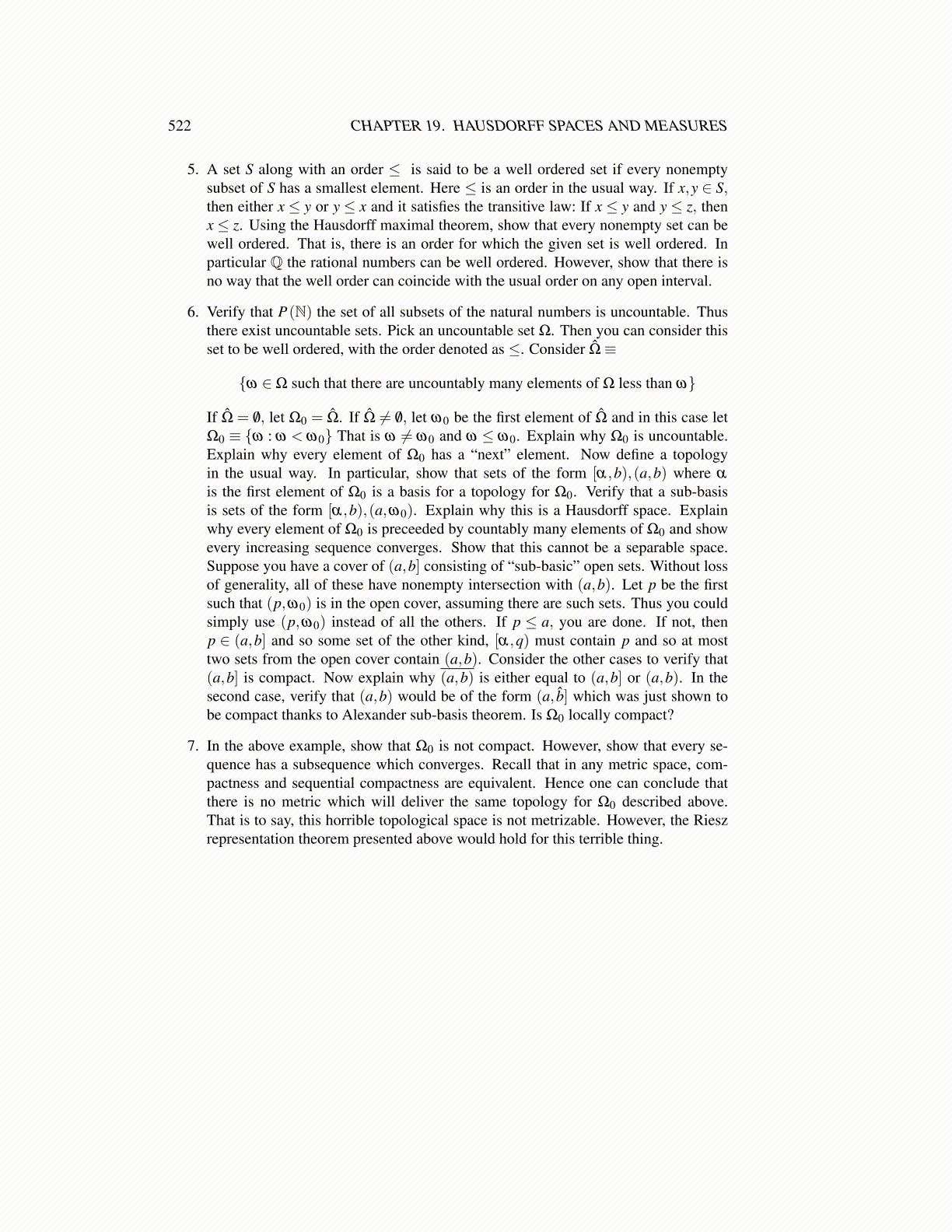
522 CHAPTER 19. HAUSDORFF SPACES AND MEASURES
5. A set S along with an order ≤ is said to be a well ordered set if every nonemptysubset of S has a smallest element. Here ≤ is an order in the usual way. If x,y ∈ S,then either x ≤ y or y ≤ x and it satisfies the transitive law: If x ≤ y and y ≤ z, thenx ≤ z. Using the Hausdorff maximal theorem, show that every nonempty set can bewell ordered. That is, there is an order for which the given set is well ordered. Inparticular Q the rational numbers can be well ordered. However, show that there isno way that the well order can coincide with the usual order on any open interval.
6. Verify that P(N) the set of all subsets of the natural numbers is uncountable. Thusthere exist uncountable sets. Pick an uncountable set Ω. Then you can consider thisset to be well ordered, with the order denoted as ≤. Consider Ω̂≡
{ω ∈Ω such that there are uncountably many elements of Ω less than ω}
If Ω̂ = /0, let Ω0 = Ω̂. If Ω̂ ̸= /0, let ω0 be the first element of Ω̂ and in this case letΩ0 ≡ {ω : ω < ω0} That is ω ̸= ω0 and ω ≤ ω0. Explain why Ω0 is uncountable.Explain why every element of Ω0 has a “next” element. Now define a topologyin the usual way. In particular, show that sets of the form [α,b),(a,b) where α
is the first element of Ω0 is a basis for a topology for Ω0. Verify that a sub-basisis sets of the form [α,b),(a,ω0). Explain why this is a Hausdorff space. Explainwhy every element of Ω0 is preceeded by countably many elements of Ω0 and showevery increasing sequence converges. Show that this cannot be a separable space.Suppose you have a cover of (a,b] consisting of “sub-basic” open sets. Without lossof generality, all of these have nonempty intersection with (a,b). Let p be the firstsuch that (p,ω0) is in the open cover, assuming there are such sets. Thus you couldsimply use (p,ω0) instead of all the others. If p ≤ a, you are done. If not, thenp ∈ (a,b] and so some set of the other kind, [α,q) must contain p and so at mosttwo sets from the open cover contain (a,b). Consider the other cases to verify that(a,b] is compact. Now explain why (a,b) is either equal to (a,b] or (a,b). In thesecond case, verify that (a,b) would be of the form (a, b̂] which was just shown tobe compact thanks to Alexander sub-basis theorem. Is Ω0 locally compact?
7. In the above example, show that Ω0 is not compact. However, show that every se-quence has a subsequence which converges. Recall that in any metric space, com-pactness and sequential compactness are equivalent. Hence one can conclude thatthere is no metric which will deliver the same topology for Ω0 described above.That is to say, this horrible topological space is not metrizable. However, the Rieszrepresentation theorem presented above would hold for this terrible thing.